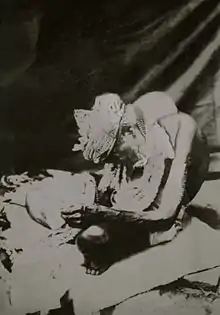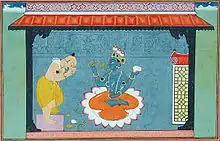Jagannatha Dasa Babaji
Jagannatha Das Babaji (IAST: Jagannātha dāsa Bābājī; 1776–1894) was an influential leader (guru) in the Gaudiya Vaishnava tradition of Hinduism, respected as a Mahātmā (saint) by followers of his lineage. He accepted initiation (diksha) from Jagadananda Goswami of Vrindavan, and later accepted babaji initiation (Vaishnava sannyasa) from Madhusudana dasa Babaji. For the rest of his life, his example as a Gaudiya Vaishnava devotee was an inspiration to many in the community. Bhaktivinoda Thakur is quoted calling him "the commanding chief of the devotees".
Jagannatha Dasa Babaji | |
|---|---|
 Jagannatha Dasa Babaji circa 1890 | |
| Born | 1776 |
| Died | 1894 |
Jagannatha Dasa Babaji was born in a small village in the modern-day Tangail district of Bangladesh (then part of the Bengal Presidency of British India). His birth year cannot be pinpointed exactly, with accounts from several different Gaudiya Vaishnava groups giving years from 1750 to 1800.
Jagannatha Dasa Babaji met Bhaktivinoda Thakur in 1880, and the latter subsequently accepted the former as his instructing (shiksha) guru. (Bipin Bihari Goswami, part of the goswami community of Baghnapara who claim descent from Chaitanya's associate, Vamsivadananda Thakur, was Bhaktivinoda's diksha, or initiating, guru.) It is said among some Gaudiya Vaishnavas that a young Bhaktisiddhanta, skilled in astronomy, created an ample Vaishnava calendar at Jagannatha Dasa Babaji's request, detailing all holidays, including the appearance and disappearance days of prominent devotees.
Jagannatha Dasa Babaji spent his last days in the areas of Vrindavan and Navadwip, where he performed bhajan and japa in worship to Radha and Krishna. A devotee named Bihari Lal would often assist the elderly sadhu. His devotion to Caitanya Mahaprabhu and instructions on Vaishnava theology to Bhaktivinoda Thakur and Gaurakisora Dasa Babaji render him an integral part of the Gaudiya Vaishnava guru-parampara.
See also
| Part of a series on |
| Vaishnavism |
|---|
 |
|
|